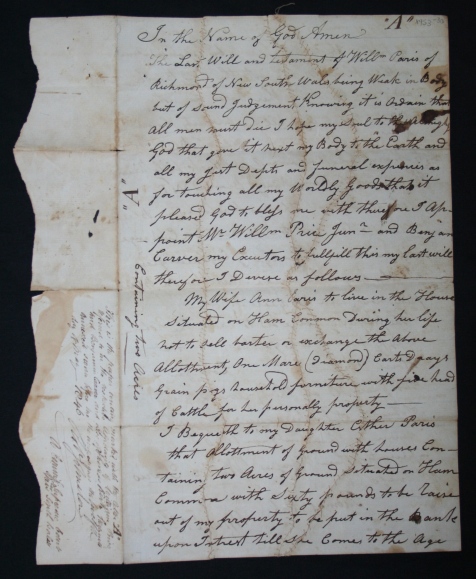Archives provide us with evidence and information about historical events and practices. This evidence is usually in the written form, however so much can be learned through the examination of the materials that the archives are made from.
Perhaps we could examine the convict stamp on a book cover; or perhaps a certain type of photographic process will help to date an image; or maybe how something has been repaired will provide valuable information about its use.
We recently discovered a little gem in our collection – a probate document that had been torn into several pieces and then hand-stitched back together with great care and skill.
This style of repair is more traditionally used to repair parchment and vellum documents. Parchment is made from animal skin and is therefore strong enough to sew. “Methods of repair [of parchment] used in centuries past were principally twofold. Edges were joined or rejoined by stitching them together (using raw hide strips or linen or hemp twine)”. (Kite and Thomson, 2006, p217)

This drawing illustrates Anthony Cains description of sewing torn parchment. (Illustration courtesy A. Cains, 1982, p19)
“The repair of healthy but physically damaged vellum can be entirely non-adhesive by using sewing and lacing methods only. Keep the laces as fine as possible…When dealing with torn text or illumination lacing has been found functionally and visually better…” (Cains, 1982, p19)
Paper was more traditionally repaired using adhesives such as starch paste, flour paste and various forms of animal glue. In more recent times acrylic adhesives and self-adhesive tapes such as “magic tape” have become the norm. State Records’ conservators today use purified wheat starch paste in combination with Japanese tissues to repair documents in our care.
The beauty of the stitch-repair method is that it is easily removable if necessary and it has left no damaging adhesive residues on the paper. The disadvantages are of course that the repair may be more visually intrusive than a thin tissue repair and it also leaves many small holes in the paper. It is also likely to take much longer to do.

This image shows the back page of the sewn probate document. This repair technique has the advantage of not obscuring any information like traditional repairs such as linen cloth or paper tape might
There are very few examples of this type of repair on paper in our collection. Another example is seen below, however as you can see the repair is fairly rudimentary and does not display the level of care or delicacy of the first example.

This ticket of leave has been sewn onto a secondary support, however the rudimentary nature of the sewing means that it is much more vulnerable than the sewn probate document
What does this repair technique tell us about the probate document? Well, of course it is all speculation, but perhaps it is that the person who did the repair did not have any glue; or it could be that the person was more used to dealing with parchment and stuck with what they felt comfortable with; maybe the repairer was a seamstress and again felt more at home with a needle and thread than a pot of glue. One thing it probably tells us with more certainty is the overall shortage of materials in days gone by as compared with now and the greater need to repair and reuse, rather than reprint or copy.

A detail of the repaired probate document illustrating how fine the repair is and how well the pieces match up
State Records has made the decision to leave the stitch-repairs in place on both of these documents as they are evidence of use and are considered to be almost contemporaneous with the creation of the documents. They are an important part of the documents’ history and will be preserved as such.
If you have any examples of this type of repair we would love to hear about them!
References:
Kite, Marion and Roy Thomson, Conservation of Leather and related materials. 2006, Butterworth-Heinemann, Oxford.
Cains, Anthony, Repair Treatments for Vellum Manuscripts. Paper Conservator, Volume 7, 1982.


Louise says:
Wow, how amazing. These people must have really valued the documents to repair them so carefully. One wonders why the will was torn up: perhaps by a sibling who wasn’t left anything? Obviously someone’s torn it up in anger and then someone’s carefully repaired it, no doubt the daughter referred to in the will.